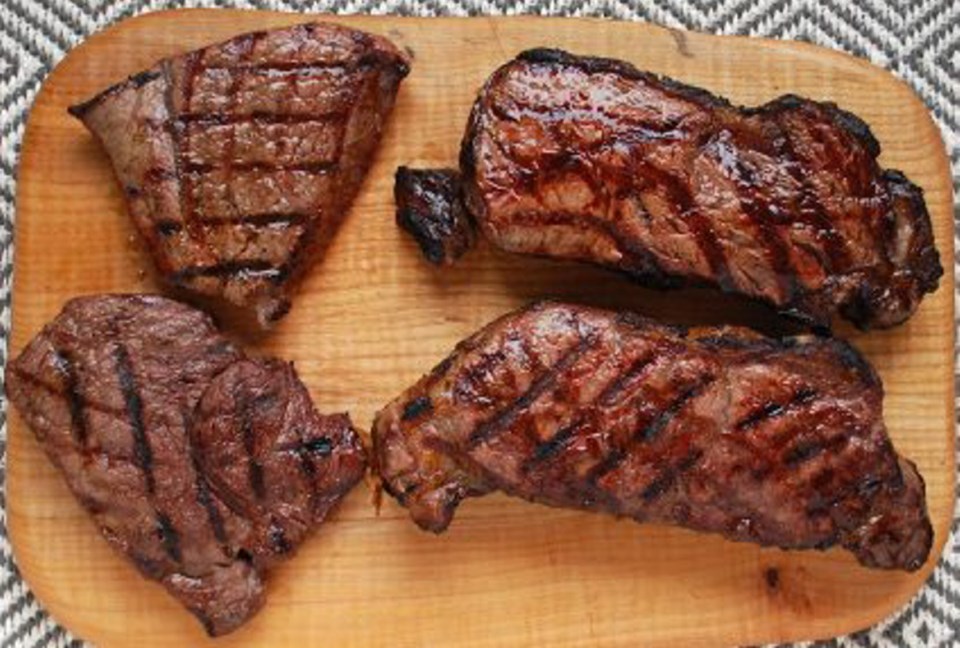 Dear Eric: Your article on “surf and turf” suggests taking steaks out of the fridge about 20 minutes prior to grilling. I used to do it this way and had very good results.
Dear Eric: Your article on “surf and turf” suggests taking steaks out of the fridge about 20 minutes prior to grilling. I used to do it this way and had very good results.
Recently — within the last year — I was watching America’s Test Kitchen on steak grilling and they suggested leaving the steaks in the fridge until you want to put them on the grill. Their point was that the hot grill will sear the outside and let the inside come to a nice rare-to-medium-rare doneness. I use this approach now and have had very good results.
Which is the best or more preferred method?
Kurt
I wrote the story Kurt is referring to just before Valentine’s Day. If you missed it, go to and search “surf and turf.”
In that article, I offered a recipe that included grilling tender beef steaks. Before doing so, I noted, you should let the steaks warm at room temperature at least 20 minutes.
When I wrote at least 20 minutes, I should have added: “or until the steaks are at room temperature,” which could actually take an hour or more, depending on thickness.
My goal in bringing the steak to room temperature, or at least taking some of the chill out of it, is to ensure it cooks more evenly, sears nicely and is warm in the middle when cooked, even when rare.
Taking the chill out of a steak before cooking is something I learned in my chef/restaurant days.
It’s also something I’ve observed when watching how other chefs cook steak in places such as a good steakhouse, or by reading about their preferred techniques in a cookbook.
For example, in barbecue champion Rockin’ Ronnie Shewchuk’s bestselling book Barbecue Secrets Deluxe, his rib-eye steak recipe tells you to let the steak come to room temperature before cooking, which will take at least an hour.
In another book, The Art of Living According to Joe Beef, the authors and operators of Montreal’s renowned Joe Beef restaurant ask you to let the strip-loin steak used in one of their recipes rest at room temperature at least three hours. They note that by that time, the meat should be at room temperature.
Conversely — as noted in Kurt’s question — America’s Test Kitchen, a highly regarded source of culinary information with a television program, websites, magazines and cookbooks, suggests your steak should be cold before cooking.
In fact, in a YouTube video and on of its websites, cookscountry.com (search “how to make the best steaks”), America’s Test Kitchen suggests you actually put the steaks, which in the video are 11⁄2-inch thick strip-loin steaks, on a rack in the freezer for 30 minutes before cooking.
Before doing that, you pat the steaks thoroughly dry, then lightly coat both sides with a mixture of kosher salt and moisture-absorbing cornstarch. The salt both seasons the steak and draws moisture to the surface.
America’s Test Kitchen notes that the moisture drawn out by the salt evaporates in the dry environment of the freezer, and the drier surface gives the steak a better crust. The very cold steak will take longer to cook, which they say means you’ll get a richer, more beautiful crust.
To see which method I preferred, I let one strip-loin steak of the same thickness warm at room temperature for one hour, and chilled another one in the freezer as America’s Test Kitchen suggested.
I then grilled each steak as per America’s Test Kitchen instructions, on a preheated grill, cooking each steak three minutes per side, before moving the steaks to a cooler part of my grill and cooking them to the desired doneness.
When I turned the steak that had warmed at room temperature, it already had lovely char on the cooked side. That bliss continued when it was cooked on the other side.
However, when I flipped the steak that had sat in the freezer for 30 minutes, it looked fairly anemic, despite the hot grill. My guess is that it was so cold, almost frozen on the outside, that it cooled down the bars of the grill it was on, mitigating its charring potential.
Because that steak did have to stay on the grill longer to achieve my desired rare-to-medium-rare in doneness, it did eventually achieve a nice crust when cooked, about 12 minutes total cooking time, versus about nine minutes for the other steak.
After I let both steaks rest on a plate after cooking for a few minutes, I cut into them.
The steak that had warmed at room temperature before cooking was warm in the middle, but the steak that had sat in the freezer was, well, room temperature. Also, the cornstarch on the steak was noticeable and negatively affected the taste of the steak.
I also cooked thinner, half- to three-quarter-inch-thick top sirloin steaks using the two methods, and the results were similar.
Lastly, I tried cooking steaks of varying thicknesses straight out of the fridge and results were mixed.
The thicker steaks when cooked were still not warm in the middle, as I like them to be, even when the meat is rare. Thinner, half- to three-quarter-inch ones were, as the heat did not have to travel as far to reach the centre of the chilled meat.
So, for my money, I’ll stick with the method of taking some or all of the chill out of a steak before cooking.
Note: When testing steaks for doneness, one thing I have not noted in past articles is that some sources, including ones I checked for this story, suggest you use an instant-read meat thermometer, particularly for thicker steaks. When the thermometer is inserted through the side of the steak into the centre of the thickest part of the meat, a rare steak will be about 120 F, medium-rare will be 125 F, and a medium steak will be 135 F.
Eric Akis is the author of The Great Rotisserie Chicken Cookbook (Appetite by Random House). His columns appear in the Life section Wednesday and Sunday.



